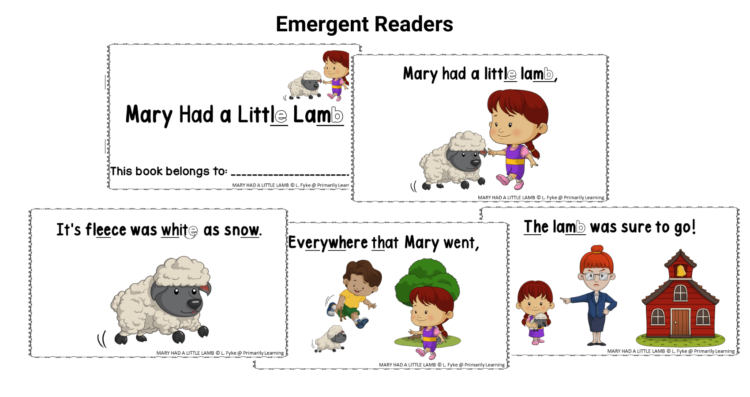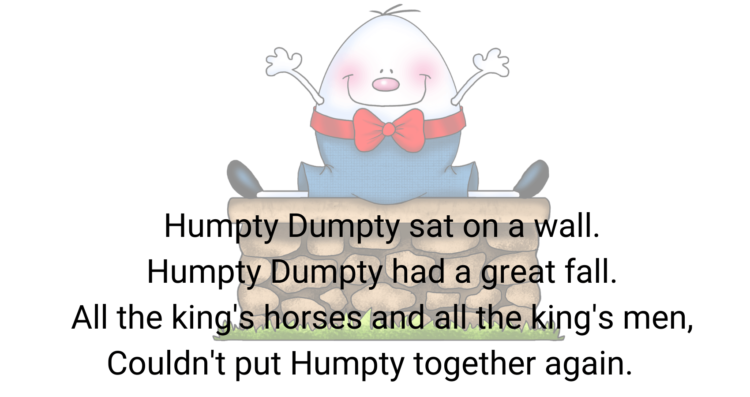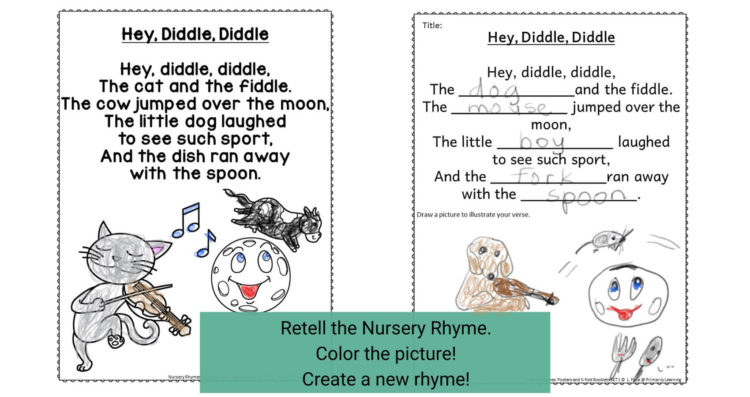Sharing is caring!


Why Recite Nursery Rhymes?
Do you remember Nursery Rhymes or similar “traditional” songs from your youth? Depending on where you live, they vary in content, but these simple, repetitive verses seem to be part of everyone’s childhood. Parents sing softly to soothe an infant, and soon, they begin retelling or singing rhymes that their parents and teachers taught them!

What are the Benefits of Retelling These Nursery Rhymes?
1. Develop Speaking and Listening Skills
Children memorize nursery rhymes through constant repetition. Have you ever observed a little one watching her parents’ lips to imitate the sound? As she followed the rhythm of the language, did you smile at her facial expressions as she listened intently? Books provide a visual connection, and the numerous videos available on YouTube add visual appeal and movement.

2. Learn About Story Structure
Nursery Rhymes often tell a story with a beginning, a middle, and an end. This story-building skill teaches kids that events happen in a sequence. And helps them to retell the rhyme. They also develop a simple understanding of sentence structure and the storytelling framework. Kids like to “read” nursery rhymes. They are learning about books and how they work.

3. Practice Early Literacy Skills
Repeating nursery rhymes builds an understanding of rhyme. The language’s rhythm helps kids understand the beats of the words as they learn about syllables. Children learn how language works and build memory skills. They learn to infer what might happen next and love to fill in the missing rhyming word. Consider the vocabulary and comprehension skills your child is developing as they learn a rhyme. Imagine the thinking in her developing brain as she tries to sort out the words and stories.

Nursery Rhymes Sequencing Activities, including Sequencing Stories with Pictures
4. Improve Articulation
Young children will practice making the words and repeat the rhymes with their parents. Singing and saying these verses strengthens their lips and tongue, which leads to improved speech. Change the rhymes! Create new verses!
5. Experience Drama, Movement & Expression
Have you ever dramatized a rhyme? Acting out rhymes encourages personal expression and movement, stimulating the brain. Watch a young child… they will automatically add expression and animate their voice!

6. Add Mathematics Skills
Nursery Rhymes follow repeated patterns. Some rhymes and songs help with counting, size, and shape.
Listen to how these rhymes have been extended. Use your imagination. What new verses can you create?

How would you change the rhyme?
Background
The first nursery rhyme collection was Tom Thumb’s Song Book by Mary Cooper around 1744. Thomas Carnan was the first to use the term Mother Goose for nursery rhymes with his Mother Goose’s Melody in 1780. (Wikipedia)
The History of Nursery Rhymes. Oh My!
We often recite rhymes with automaticity and don’t even consider the words that are spoken. I caught myself when I started singing, “It’s raining, it’s pouring; the old man is snoring. He bumped his head, and he went to bed, and he couldn’t get up in the morning.” I tend not to read too much into the text, but instead use it as a story. We talk about what’s happening in the story and sometimes create our own context.
However, I researched nursery rhymes and was surprised to learn about the dark meaning behind them. If you are interested…
10 Dark and Disturbing Origins of Popular Nursery Rhymes
The Dark Side of Nursery Rhymes
Keep me in the dark!
I like the innocent repetition of nursery rhymes. Repeating rhymes provides numerous and varied learning opportunities for early learners, and it’s fun! Think of the memorable moments you will create… the smiles and laughter you’ll share with your child or class!
“Research has found that when a child knows eight or more nursery rhymes by heart, at the age of 4, they are usually one of the best at reading and spelling in their class by the age of 8!” Little Signers Club.
A Quick Recap:
Nursery Rymes Provide Learning Opportunities for Children to:
- develop speaking and listening skills
- grasp an understanding of rhyme
- learn about syllables and sentence structure
- gain an understanding of the story structure
- improve articulation
- develop memory skills
- increase vocabulary
- experience drama, movement, and expression
- practice mathematics skills

🌟 Check out this Engaging Nursery Rhyme BUNDLE 🌟 Emergent Readers, Posters, Sequencing, Word Work, and Take-Home Books for 8 Rhymes – ➡️ 385 pages!
15 Popular Nursery Rhymes
- Twinkle Twinkle Little Star
- Hey Diddle Diddle
- Jack and Jill
- Little Miss Muffet
- This Little Piggy
- Humpty Dumpty
- The Wheels on the Bus
- Hickory Dickory Dock
- Mary Had a Little Lamb
- Old Macdonald Had a Farm
- Row Row Row Your Boat
- Grand Old Duke of York
- Itsy Bitsy Spider, Eensy Weensy Spider
- One, Two, Three, Four, Five
- Zoom, Zoom, Zoom
Singing, dancing, and dramatizing Nursery Rhymes can be educational and fun!
We come from diverse backgrounds and cultures. Please share your family’s traditional rhymes or early storytelling verses in the comments!

Wishing you a marvelous week!
Laurie







